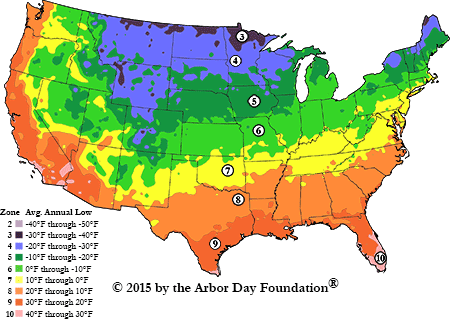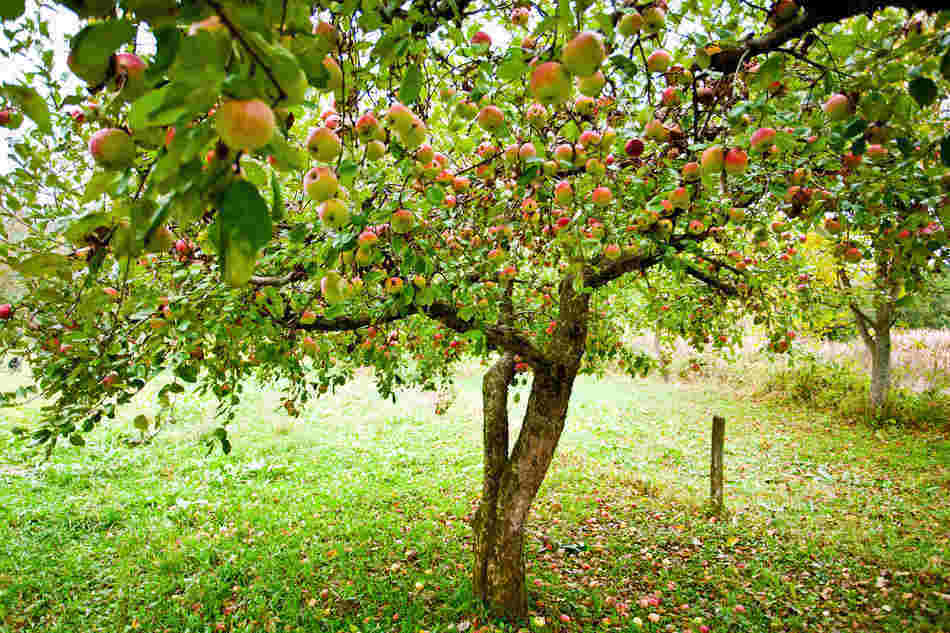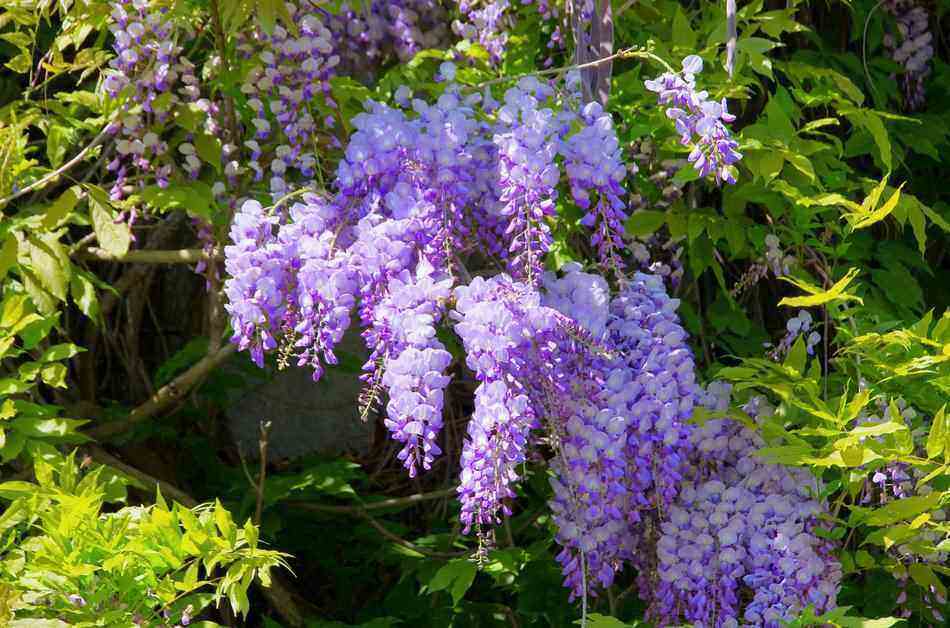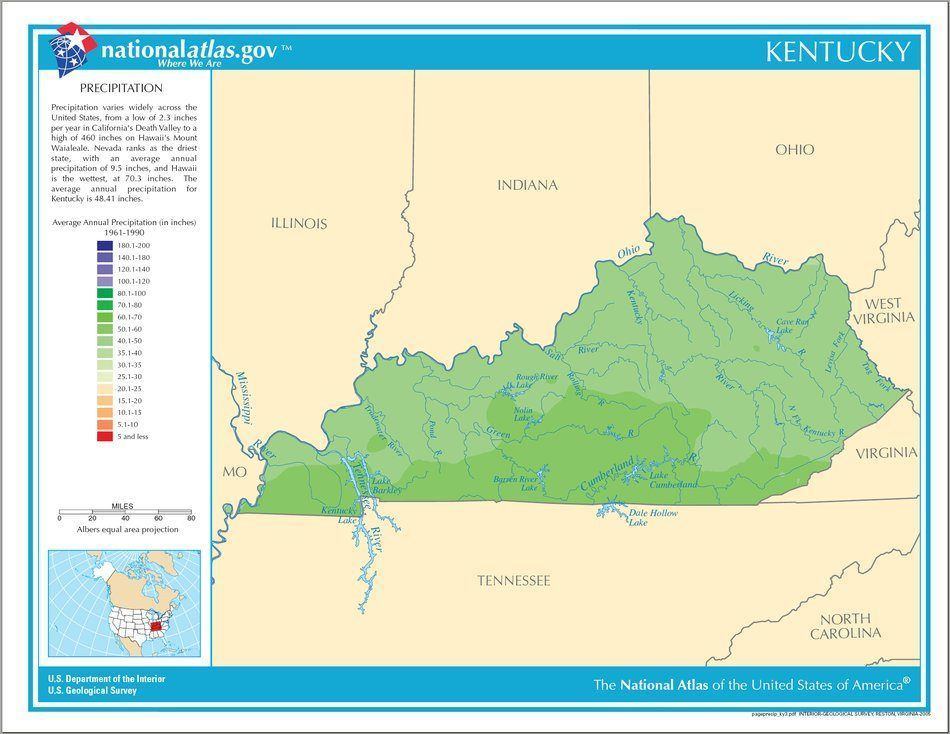The United States Department of Agriculture (USDA) Hardiness Zone Scale is something most successful gardeners are aware of, and you know your zone, it’s easier to grow successfully in your climate. In Kentucky, the KY Hardiness Zone helps you decide what plants will tolerate the coldest temperatures.
Located in the upland South and stretching into the Appalachia, Kentucky has an excellent growing season. The KY Hardiness Zone is Zone 6 on the USDA Hardiness Scale, which means that the average extreme minimum low temperature is -5 to 0 degrees F (or -20.6 to -17.8 degrees C).
The USDA Hardiness Zone Scale is based on the average lowest temperature in a particular climate, and you can simply look up your ZIP code or state and discover which zone you reside in.
Kentucky typically gets the ideal amount of rain and, although occasionally the state is met with drought conditions, the growing season is excellent.
There are very few months that plants don’t grow in Kentucky, and a great variety of vegetation is native to the state.
Even tropical plants, for the most part, thrive in Kentucky.

What is the USDA hardiness zone?
The USDA Hardiness Zone Scale was created as a way to help gardeners in the United States.
By dividing the country into zones based on temperature, it takes a lot of the guesswork out of deciding which plants will thrive.
The scale groups climates that have an average lowest temperature in 10-degree (F) increments.
Zone 1 is the coldest and the warmest is zone 13.
The first USDA hardiness zone map was created in 1960 and quickly became widespread among American gardeners.
It was revamped in 1990 and split the geographical regions into subzones labeled with A and B, separated by 5-degree (F) increments within the 10-degree (F) number increments.
Each of the regions in the USA now have a number and letter value on the scale.
The continental United States have a coldest zone of 3a (Minnesota) and a warmest zone of 11b (Florida Keys).
The scale has been adapted to most climates in the world.
The USDA Hardiness Zone Scale is a standard scale for most gardeners and many people know their zone and facts about the plants that grow best within their zone.
Most of the United States falls in the middle of the scale, from zones 6-8. Kentucky is situated in this “sweet spot” as well.
Most of the state is located in zone 6, but some of the warmest parts are grouped into zone 7.
KY Hardiness Zone for growing
Kentucky’s growing season is long. The season starts in the beginning of April and finishes at the end of October.
That means more than 200 days in the growing season–and that means opportunities for multiple crops in a single season.
Because Kentucky’s climate is temperate, certain crops can be planted prior to the last spring frost.
Typically, the last frost occurs at the end of April to mid-May. The first fall frost falls between mid-October and early November.
However, most of the early frosts are not damaging to hardy plants and there are many vegetables and flowers that can survive these gentle frosts.
Kentucky typically receives ideal amount of rainfall for plants to grow (40-50 inches, or 101-127 cm).
However, occasionally the state can go through periods of drought during the growing season.
Plants should be on a watering schedule, which will obviously increase in times of drought.

Best plants for KY Hardiness Zone
The following chart details the best plants to grow in zone 6.
The chart doesn’t account for differences in the soil or rainfall.
It simply provides a list of plants that grow best according to the temperature for the predominant hardiness zone in Kentucky.
| Apples | Arugula |
| Asparagus | Asters |
| Astilbe | Basil |
| Beans | Bee Balm |
| Beets | Bell Peppers |
| Black-Eyed Susans | Blackberries |
| Blueberries | Broccoli |
| Brussels Sprouts | Butterfly Bush |
| Cabbage | Cannas |
| Cantaloupes | Carrots |
| Celery | Cherries |
| Chives | Chrysanthemums |
| Columbine | Coneflowers |
| Corn | Crocuses |
| Cucumbers | Daffodils |
| Delphiniums | Dill |
| Edamame | Eggplants |
| Garlic | Gladiolus |
| Grapes | Hibiscus |
| Hostas | Hyacinth and Muscari |
| Hydrangeas | Irises |
| Lavender | Lettuce |
| Lilacs | Lilies |
| Lupines | Marigolds |
| Morning Glories | Okra |
| Onions | Pansies |
| Parsnips | Peaches |
| Pears | Peas |
| Peonies | Phlox |
| Plums | Potatoes |
| Pumpkins | Radishes |
| Raspberries | Rhododendrons |
| Rutabagas | Sage |
| Salvia | Sedum |
| Shasta Daisies | Spinach |
| Strawberries | Sunflowers |
| Sweet Potatoes | Swiss Chard |
| Thyme | Tomatoes |
| Tulips | Turnips |
| Veronica (Speedwell) | Watermelons |
| Wisteria | Yarrow |
| Zinnias |
Although this list is fairly exhaustive, it does not separate plants into vegetables, fruits, perennials, or annuals.
It also does not state whether plants are early or late bloomers or cold or hot weather.
Always do further research on the plants you intend to grow!

Garden planning for Kentucky’s Hardiness Zone
If you trying to maximize the Kentucky growing season, you need to plan for multiple crops.
It takes some strategic planning to decide where you will begin in March, but with some experience, you should be able to get multiple crops of both vegetables and flowers.
To help with some garden planning, here is a brief month-by-month breakdown of what you can do in your garden in Kentucky:
| January | In January, provided the weather is not too cold, you can begin pruning trees for the upcoming summer. Pruning fruit trees is especially important, as the fruit’s higher quality when it comes from a pruned tree. |
| February | It’s time to start your garden seeds (inside) in February! It’s also a good idea to check your outdoor plants for water levels. If it’s been a particularly dry winter, these plants could benefit from a little extra water. |
| March | Begin planting cold weather vegetables from seed in the ground. These plants should be hardy and able to withstand light frost. March is also the month to start pruning late-blooming perennials. |
| April | April is the month to being planting early annuals. This includes vegetables and flowers. These should be planted from seed, as they will need to withstand some frost. |
| May | May should see the end of frost. This means you can start planting warm season annual flowers and vegetables. You can also plant tropical plants in May. If you intend to keep these throughout the winter, keep them planted in pots that you can move indoors. |
| June | You can start to replace your early annuals in June. This is the month to begin second crops. |
| July | Start your first big harvest in July! Vegetables will start to really produce and some early fruits will be ready as well. As plants finish producing, you can start replacing the plants. |
| August | Continue harvesting and watering throughout August. Most vegetables will finish in August and there should also be many fruits to pick! |
| September | In September, temperatures begin to cool and the growing season slows. This is the perfect time to begin planting cool season annuals. Perennials can also be planted for the next growing season (they will go dormant during the cool season). Perennials can also be transplanted during the fall. Any warm perennials should be moved indoors prior to the first frost. |
| October | Any later vegetables should be picked and finished this month prior to hard frost. You can continue pruning and transplanting perennials throughout October. |
| November | Plant spring bulbs, such as daffodils, tulips, and crocuses. Ensure all annuals are cleaned up and the soil is ready for next spring. |
| December | Make your evergreens the stars for the holidays! You can also add potted poinsettias for a pop of color. |

Typical weather patterns for KY Hardiness Zone
Kentucky is one of the many places that is blessed with four distinct seasons.
It’s central to the USA, and because of this, the temperatures are quite mild. Summers are hot and long, and winters are moderately cold.
The landscape looks vastly different depending on the season. Spring is filled with bright colors, bluegrass, and the buzz of outdoor activity reawakening after winter.
Summer is hot and lush. There are frequent thunderstorms and a lot of sun. The UV is high, even with cloud cover.
Fall is stunning, with changes to the leaves beginning as early as mid-September in some parts of the state.
Fall foliage peaks throughout the state in mid-October.
Winter is quiet, as people begin to stay indoors for the cold season. Kentucky receives an average of 11 inches of snow in the winter. The mountains are particularly beautiful in the winter.
Most years, Kentucky receives enough precipitation to adequately grow plants. However, most gardeners will still water according to a schedule.
Sometimes Mother Nature throws us for a loop and we have a year that is too wet or too dry. While both can be problematic to a garden, it’s possible to overcome either weather condition.
Wet weather
If the growing season looks to be overly wet, plan your garden accordingly.
Plan to raise your garden so it won’t have to be in standing water for long periods of time. Mix your garden soil with compost and perlite for optimal drainage.
Plan to start your plants indoors, as it’s easier for already established plants to grow in wet soil than seeds (seeds tend to rot in wet soil).
When your plants are growing in saturated soil, monitor them for infections.
If leaves start to show signs of infection, cut them off immediately to stop the spread of fungus.
Watch for slugs, as they tend to thrive in wet environments.
Limit hiding places for slugs (boards, stones) as they will feed on the leaves of your plants. For more information on managing slugs look here.
Dry weather
On the other hand, if your garden starts experiencing drought, it can be just as concerning and requires action to minimize damage to plants.
When temperatures soar and the rain refuses to come, it’s time to start watering. Most plants need about an inch of water every week.
This will need to increase if it’s especially hot and dry, but in general, an inch/week is a good rule to garden by.
Mulch your soil. Mulch leads to less water being lost through evaporation, which means plants get to keep more moisture and nutrients.
It also allows the soil to stay cooler, which protects the roots of the plants.
Although deadheading and weeding are always important, these (boring) tasks are even more important in drought.
Plants don’t need to expend any extra energy on dead flowers and should not be competing for root space during drought!
It’s always a good idea to continue watering perennials (including shrubs and trees) after they’ve stopped producing for the year.
When perennials are preparing to go dormant, they are in a vulnerable state. If they experience drought during this time, it can take years for the plants to begin to flourish again.
Drought can make plants less resistant to cold weather conditions, which means your perennials will be less likely to survive the winter.
Related Questions
What planting zone is KY? Kentucky is a large state that stretches into planting zones 6a, 6b, and 7a. Zone 6b is the predominant KY Hardiness Zone.
What planting zone is Eastern Kentucky? Eastern Kentucky has a planting zone of 6b, like the majority of the state. This means that plants that are hardy to zone 6 will thrive in eastern Kentucky.
What is zone 6b? Zone 6 is one of 13 hardiness zones as defined by the USDA Hardiness Zone Map. Zone 6 has an average lowest temperature of -10 degrees F to 0 degrees F. Subzone 6a has an average lowest temperature of -10 degrees F to -5 degrees F, while subzone 6b has an average lowest temperature of -5 degrees F to 0 degrees F.
What can you grow in Kentucky? Kentucky has an enviable growing season, fantastic cinder soil, and four distinct seasons. Because of this, there are many vegetables, fruits, trees, shrubs, and flowers that grow well in the state. Because Kentucky has long, hot summers, heat-loving vegetables and fruits grow well. Due to the cool spring and fall temperatures, it’s also possible to get cool-loving crops in too!

